The Impact Analysis of Psychological Issues and Pandemic-Related Variables on Ecuadorian University Students during COVID-19
Abstract
1. Introduction
- (1)
- To determine and analyze the validity of the questions of the instrument used in this research.
- (2)
- To describe how university students have dealt with negative emotions and Pandemic-related issues during the pandemic and how much.
- (3)
- To analyze if there is any difference in demographic variables concerning negative emotions and these Pandemic-related issues.
- (4)
- To establish a multiple regression analysis that quantifies the effects of these issues related to pandemics on the negative feelings of university students.
2. Materials and Methods
2.1. Related Literature
2.2. Hypotheses
2.3. Sample and Recruiting
2.4. Missing Data
2.5. Instrument
2.5.1. Negative Emotions
2.5.2. Pandemic-Related Behavior
2.5.3. Pandemic-Related Behavior before, after, and Variation
2.5.4. Home Infrastructure
2.6. Data Analysis Procedure
2.6.1. Confirmatory Factor Analysis Procedure
2.6.2. Statistical Analysis of the Best Model’s Variables
2.6.3. Descriptive and Inferential Analysis Procedure for Variables of Interest
2.6.4. Multiple Regression Analysis
2.6.5. Regression Analysis Consideration
3. Results
3.1. Participant’s Description
3.2. Confirmatory Factor Analysis (CFA)
3.3. Structural Equation Model (SEM)
3.3.1. Covariance Significance and Structural Equation Model
3.3.2. R-Square Values
3.4. Variables’ Statistical Analysis (Model 4 Variables)
Scores’ Preliminary Analysis by Gender and Family Income
3.5. Inferential and Descriptive Analysis
3.5.1. Parametricity
3.5.2. Negative Emotions
3.5.3. Pandemic-Related Behavior after COVID-19
3.5.4. Pandemic-Related-Behavior Variation
3.5.5. Home Infrastructure
3.6. Multiple Regression Analysis
4. Discussion
4.1. Proportions Comparison
4.2. Significant Impact Comparison
4.3. Contributions
4.4. Limitations and Future Work
5. Conclusions
Author Contributions
Funding
Institutional Review Board Statement
Informed Consent Statement
Data Availability Statement
Acknowledgments
Conflicts of Interest
References
- Wang, C.; Pan, R.; Wan, X.; Tan, Y.; Xu, L.; McIntyre, R.S.; Choo, F.N.; Tran, B.; Ho, R.; Sharma, V.K.; et al. A longitudinal study on the mental health of general population during the COVID-19 epidemic in China. Brain Behav. Immun. 2020, 87, 40–48. [Google Scholar] [CrossRef]
- Padrón, I.; Fraga, I.; Vieitez, L.; Montes, C.; Romero, E. A Study on the Psychological Wound of COVID-19 in University Students. Front. Psychol. 2021, 12, 589927. [Google Scholar] [CrossRef]
- da Conceição, V.; Rothes, I.; Gusmão, R.; Barros, H. Depression and anxiety before and during the COVID-19 lockdown: A longitudinal cohort study with university students. MedRxiv 2021. [Google Scholar] [CrossRef]
- Zhang, Y.; Zhang, H.; Ma, X.; Di, Q. Mental health problems during the COVID-19 pandemics and the mitigation effects of exercise: A longitudinal study of college students in China. Int. J. Environ. Res. Public Health 2020, 17, 3722. [Google Scholar] [CrossRef]
- El Universo. Ecuador confirma primer caso de coronavirus. El Universo, 29 February 2020; 1. [Google Scholar]
- Loaiza, Y. La pandemia del coronavirus dejó al Ecuador más de 400.000 nuevos pobres y más de 500.000 empleos perdidos. Infobae, 27 September 2021; 1. [Google Scholar]
- Browning, M.H.E.M.; Larson, L.R.; Sharaievska, I.; Rigolon, A.; McAnirlin, O.; Mullenbach, L.; Cloutier, S.; Vu, T.M.; Thomsen, J.; Reigner, N.; et al. Psychological impacts from COVID-19 among university students: Risk factors across seven states in the United States. PLoS ONE 2021, 16, e0245327. [Google Scholar] [CrossRef]
- Li, W.W.; Yu, H.; Miller, D.J.; Yang, F.; Rouen, C. Novelty Seeking and Mental Health in Chinese University Students Before, During, and After the COVID-19 Pandemic Lockdown: A Longitudinal Study. Front. Psychol. 2020, 11, 600739. [Google Scholar] [CrossRef] [PubMed]
- Bao, X.; Ji, P.; Lin, W.; Perc, M.; Kurths, J. The impact of COVID-19 on the worldwide air transportation network. R. Soc. Open Sci. 2021, 8, 210682. [Google Scholar] [CrossRef]
- Wolfe, K.; Sirota, M.; Clarke, A.D.F. Age differences in COVID-19 risk-taking, and the relationship with risk attitude and numerical ability. R. Soc. Open Sci. 2021, 8, 201445. [Google Scholar] [CrossRef]
- Riello, M.; Purgato, M.; Bove, C.; MacTaggart, D.; Rusconi, E. Prevalence of post-traumatic symptomatology and anxiety among residential nursing and care home workers following the first COVID-19 outbreak in Northern Italy. R. Soc. Open Sci. 2020, 7, 200880. [Google Scholar] [CrossRef]
- Schunk, D.; Wagner, V. What determines the willingness to sanction violations of newly introduced social norms: Personality traits or economic preferences? evidence from the COVID-19 crisis. J. Behav. Exp. Econ. 2021, 93, 101716. [Google Scholar] [CrossRef]
- Qin, X.; Yam, K.C.; Ma, G.; Chen, C.; Zhu, H.; Wang, H. The unintended psychological and behavioral drawbacks of big push strategies: Increased psychological entitlement, selfish behavior, and decreased prosocial behavior. J. Behav. Exp. Econ. 2022, 97, 101842. [Google Scholar] [CrossRef]
- Faubion, D. What Is Psychological Distress? An Overview [Internet]. 2021. Available online: https://www.betterhelp.com/advice/grief/what-is-psychological-distress-an-overview/ (accessed on 15 September 2022).
- Odriozola-González, P.; Planchuelo-Gómez, Á.; Irurtia, M.J.; de Luis-García, R. Psychological effects of the COVID-19 outbreak and lockdown among students and workers of a Spanish university. Psychiatry Res. 2020, 290, 113108. [Google Scholar] [CrossRef] [PubMed]
- Zhao, Y. Psychological Impacts of the COVID-19 Outbreak on Chinese International Students: Examining Prevalence and Associated Factors. World J. Educ. Res. 2020, 7, 45. [Google Scholar] [CrossRef]
- Islam, M.S.; Sujan, M.S.H.; Tasnim, R.; Sikder, M.T.; Potenza, M.N.; van Os, J. Psychological responses during the COVID-19 outbreak among university students in Bangladesh. PLoS ONE 2020, 15, e0245083. [Google Scholar] [CrossRef]
- Akhihiero, E.T. Effect of Inadequate Infrastructural Facilities on Academic Performance of Students of Oredo Local Government Area of Edo State. The Nigerian Academic Forum, 2011; Volume 20. [Google Scholar]
- Cortés-Álvarez, N.Y.; Piñeiro-Lamas, R.; Vuelvas-Olmos, C.R. Psychological Effects and Associated Factors of COVID-19 in a Mexican Sample. Disaster Med. Public Health Prep. 2020, 14, 413–424. [Google Scholar] [CrossRef]
- Ghazawy, E.R.; Ewis, A.A.; Mahfouz, E.M.; Khalil, D.M.; Arafa, A.; Mohammed, Z.; Mohammed, E.-N.F.; Hassan, E.E.; Hamid, S.A.; Ewis, S.A.; et al. Psychological impacts of COVID-19 pandemic on the university students in Egypt. Health Promot. Int. 2021, 36, 1116–1125. [Google Scholar] [CrossRef]
- Spitzer, R.L.; Kroenke, K.; Williams, J.B.W.; Löwe, B. A Brief Measure for Assessing Generalized Anxiety Disorder The GAD-7. Arch. Intern. Med. 2006, 166, 1092–1097. [Google Scholar] [CrossRef]
- Spinhoven, P.; Ormel, J.; Sloekers, P.P.A.; Kempen, G.I.J.M.; Speckens, A.E.M.; Van Hemert, A.M. A validation study of the Hospital Anxiety and Depression Scale (HADS) in different groups of Dutch subjects. Psychol. Med. 1997, 27, 363–370. [Google Scholar] [CrossRef]
- Lotrakul, M.; Sumrithe, S.; Saipanish, R. Reliability and validity of the Thai version of the PHQ-9. BMC Psychiatry 2008, 8, 46. [Google Scholar] [CrossRef]
- Zung, W.W.K. A Rating Instrument For Anxiety Disorders. Psychosomatics 1971, 12, 371–379. [Google Scholar] [CrossRef]
- Aslan, I.; Ochnik, D.; Çınar, O. Exploring perceived stress among students in Turkey during the COVID-19 pandemic. Int. J. Environ. Res. Public Health 2020, 17, 8961. [Google Scholar] [CrossRef]
- Zurlo, M.C.; Cattaneo Della Volta, M.F.; Vallone, F. COVID-19 Student Stress Questionnaire: Development and Validation of a Questionnaire to Evaluate Students’ Stressors Related to the Coronavirus Pandemic Lockdown. Front. Psychol. 2020, 11, 576758. [Google Scholar] [CrossRef]
- Khan, A.H.; Sultana, M.S.; Hossain, S.; Hasan, M.T.; Ahmed, H.U.; Sikder, M.T. The impact of COVID-19 pandemic on mental health & wellbeing among home-quarantined Bangladeshi students: A cross-sectional pilot study. J. Affect. Disord. 2020, 277, 121–128. [Google Scholar]
- Tomaszek, K.; Muchacka-Cymerman, A. Thinking about my existence during COVID-19, i feel anxiety and awe—The mediating role of existential anxiety and life satisfaction on the relationship between PTSD symptoms and post-traumatic growth. Int. J. Environ. Res. Public Health 2020, 17, 7062. [Google Scholar] [CrossRef]
- Johansyah, M.D.; Sidharta, I. Exploring Trait Emotional Intelligent: Survey on Students during COVID-19. Sci. J. Manag. 2020, 8, 70–77. [Google Scholar] [CrossRef]
- Nurunnabi, M.; Hossain, S.F.A.H.; Chinna, K.; Sundarasen, S.; Khoshaim, H.B.; Kamaludin, K.; Baloch, G.M.; Sukayt, A.; Shan, X. Coping strategies of students for anxiety during the COVID-19 pandemic in China: A cross-sectional study. F1000Research 2020, 9, 16. [Google Scholar] [CrossRef]
- Risal, A.; Shikhrakar, S.; Mishra, S.; Kunwar, D.; Karki, E.; Shrestha, B.; Khadka, S.; Holen, A. Anxiety and Depression During COVID-19 Pandemic Among Medical Students in Nepal. Res. Sq. 2020, 1–11. [Google Scholar] [CrossRef]
- Arënliu, A.; Bërxulli, D.; Perolli-Shehu, B.; Krasniqi, B.; Gola, A.; Hyseni, F. Anxiety and depression among Kosovar university students during the initial phase of outbreak and lockdown of COVID-19 pandemic. Health Psychol. Behav. Med. 2021, 9, 239–250. [Google Scholar] [CrossRef]
- Sood, S.; Sharma, A. Resilience and Psychological Well-Being of Higher Education Students During COVID-19: The Mediating Role of Perceived Distress. J. Health Manag. 2020, 22, 606–617. [Google Scholar] [CrossRef]
- Aylie, N.S.; Mekonen, M.A.; Mekuria, R.M. The Psychological Impacts of COVID-19 Pandemic Among University Students in Bench-Sheko Zone, South-west Ethiopia: A Community-based Cross-sectional Study. Psychol. Res. Behav. Manag. 2020, 13, 813–821. [Google Scholar] [CrossRef]
- Khawar, M.B.; Abbasi, M.H.; Hussain, S.; Riaz, M.; Rafiq, M.; Mehmood, R.; Sheikh, N.; Amaan, H.N.; Fatima, S.; Jabeen, F.; et al. Psychological impacts of COVID-19 and satisfaction from online classes: Disturbance in daily routine and prevalence of depression, stress, and anxiety among students of Pakistan. Heliyon 2021, 7, e07030. [Google Scholar] [CrossRef]
- Al-Tammemi, A.B.; Akour, A.; Alfalah, L. Is It Just About Physical Health? An Online Cross-Sectional Study Exploring the Psychological Distress Among University Students in Jordan in the Midst of COVID-19 Pandemic. Front. Psychol. 2020, 11, 562213. [Google Scholar] [CrossRef]
- Arima, M.; Takamiya, Y.; Furuta, A.; Siriratsivawong, K.; Tsuchiya, S.; Izumi, M. Factors associated with the mental health status of medical students during the COVID-19 pandemic: A cross-sectional study in Japan. BMJ Open 2020, 10, 7. [Google Scholar] [CrossRef]
- Adewale, B.A.; Adeniyi, Y.C.; Adeniyi, O.A.; Ojediran, B.C.; Aremu, P.S.; Odeyemi, O.E.; Akintayo, A.D.; Oluwadamilare, F.A.; Offorbuike, C.B.; Owoeye, I.P. Psychological Impact of COVID-19 Pandemic on Students at the University of Ibadan in Nigeria. J. Educ. Soc. Behav. Sci. 2021, 34, 79–92. [Google Scholar] [CrossRef]
- Zhang, S.; Chen Jiyao Yin, A.; Yáñez, J.A. Mental health symptoms during the COVID-19 pandemic in developing countries: A systematic review and meta-analysis. J. Glob. Health 2022, 12, 05011. [Google Scholar]
- Rosli, M.S.; Saleh, N.S. Technology enhanced learning acceptance among university students during COVID-19: Integrating the full spectrum of Self-Determination Theory and self-efficacy into the Technology Acceptance Model. Curr. Psychol. 2022, 1–20. [Google Scholar] [CrossRef]
- Stolk, J.D.; Gross, M.D.; Zastavker, Y.V. Motivation, pedagogy, and gender: Examining the multifaceted and dynamic situational responses of women and men in college STEM courses. Int. J. STEM Educ. 2021, 8, 1–19. [Google Scholar] [CrossRef]
- Baena-Diéz, J.M.; Barroso, M.; Cordeiro-Coelho, S.I.; Diáz, J.L.; Grau, M. Impact of COVID-19 outbreak by income: Hitting hardest the most deprived. J. Public Health 2020, 42, 698–703. [Google Scholar] [CrossRef]
- Carroll, N.; Sadowski, A.; Laila, A.; Hruska, V.; Nixon, M.; Ma, D.W.; Haines, J.J.; on behalf of the Guelph Family Health Study. The Impact of COVID-19 on Health Behavior, Stress, Financial and Food Security among Middle to High Income Canadian Families with Young Children. Nutrients 2020, 12, 2352. [Google Scholar] [CrossRef]
- Conrad, R.C.; Hahm, H.C.; Koire, A.; Pinder-Amaker, S.; Liu, C.H. College student mental health risks during the COVID-19 pandemic: Implications of campus relocation. J. Psychiatr. Res. 2021, 136, 117–126. [Google Scholar] [CrossRef]
- Akhtarul Islam, M.; Barna, S.D.; Raihan, H.; Nafiul Alam Khan, M.; Tanvir Hossain, M. Depression and anxiety among university students during the COVID-19 pandemic in Bangladesh: A web-based cross-sectional survey. PLoS ONE 2020, 15, e0238162. [Google Scholar]
- Kapasia, N.; Paul, P.; Roy, A.; Saha, J.; Zaveri, A.; Mallick, R.; Barman, B.; Das, P.; Chouhan, P. Impact of lockdown on learning status of undergraduate and postgraduate students during COVID-19 pandemic in West Bengal, India. Child. Youth Serv. Rev. 2020, 116, 105194. [Google Scholar] [CrossRef] [PubMed]
- Kemi, M.F.; Chijioke, U. Personal Study, Peer Engagement and Learning Infrastructure Access During COVID-19 Shock: Implication for Rural Based-University Students’ in 4Ir. e-BANGI 2021, 18, 230–243. [Google Scholar]
- Küsel, J.; Martin, F.; Markic, S. University Students’ Readiness for Using Digital Media and Online Learning—Comparison between Germany and the USA. Educ. Sci. 2020, 10, 313. [Google Scholar] [CrossRef]
- Aristovnik, A.; Keržič, D.; Ravšelj, D.; Tomaževič, N.; Umek, L. Impacts of the COVID-19 pandemic on life of higher education students: A global perspective. Sustainability 2020, 12, 8438. [Google Scholar] [CrossRef]
- Audemard, J. Objectifying Contextual Effects. The Use of Snowball Sampling in Political Sociology. BMS Bull. Sociol. Methodol./Bull. Methodol. Sociol. 2020, 145, 30–60. [Google Scholar]
- von der Fehr, A.; Sølberg, J.; Bruun, J. Validation of networks derived from snowball sampling of municipal science education actors. Int. J. Res. Method Educ. 2018, 41, 38–52. [Google Scholar] [CrossRef]
- Association, E.U. The European University Association [Internet]. 2020. Available online: https://eua.eu/partners-news/492-esu’s-survey-on-student-life-during-the-COVID-19-pandemic.html (accessed on 15 September 2022).
- University of Ljubljana. One Click Survey [Internet]. 2019. Available online: https://www.1ka.si/d/en/about/general-description (accessed on 15 September 2022).
- Bonett, D.G.; Wright, T.A. Cronbach’s alpha reliability: Interval estimation, hypothesis testing, and sample size planning. J. Organ. Behav. 2015, 36, 3–15. [Google Scholar] [CrossRef]
- Fornell, C.; Larcker, D.F. Evaluating structural equation models with unobservable variables and measurement error. J. Mark. Res. 1981, 18, 39–50. [Google Scholar] [CrossRef]
- Gerbing, D.W.; Hamilton, J.G. Viability of exploratory factor analysis as a precursor to confirmatory factor analysis. Struct. Equ. Model. 1996, 3, 62–72. [Google Scholar] [CrossRef]
- Keržič, D.; Alex, J.K.; Pamela Balbontín Alvarado, R.; Bezerra, D.D.S.; Cheraghi, M.; Dobrowolska, B.; Fagbamigbe, A.F.; Faris, M.E.; França, T.; González-Fernández, B.; et al. Academic student satisfaction and perceived performance in the e-learning environment during the COVID-19 pandemic: Evidence across ten countries. PLoS ONE 2021, 16, e0258807. [Google Scholar] [CrossRef]
- Schermelleh-Engel, K.; Moosbrugger, H.; Müller, H. Evaluating the fit of structural equation models: Tests of significance and descriptive goodness-of-fit measures. MPR-Online 2003, 8, 23–74. [Google Scholar]
- Westland, J.C. An introduction to structural equation models. Stud. Syst. Decis. Control. 2015, 22, 1–8. [Google Scholar]
- Hair, J.F., Jr.; Anderson, R.E.; Tatham, R.L.B. Multivariate Data Analysis, 7th ed.; Pearson Educational International: Upper Saddle River, NJ, USA, 2010; Available online: https://imaging.mrc-cbu.cam.ac.uk/statswiki/FAQ/Simon (accessed on 15 September 2022).
- Langer, W., Dr. How to Use Stata’s Sem Command with Nonnormal Data? A New Nonnormality Correction for the RMSEA, CFI and TLI; Martin-Luther-University Halle-Wittenberg: Halle, Germany, 2019. [Google Scholar]
- Kaplan, D. Structural Equation Modeling. In International Encyclopedia of the Social & Behavioral Sciences; Elsevier: Amsterdam, The Netherlands, 2001; pp. 15215–15222. [Google Scholar]
- Chyung, S.Y.Y.; Roberts, K.; Swanson, I.; Hankinson, A. Evidence-Based Survey Design: The Use of a Midpoint on the Likert Scale. Perform. Improv. 2017, 56, 15–23. [Google Scholar] [CrossRef]
- Altman, E.I.; Haldeman, R.G.; PNarayanan, P. ZETATM analysis A new model to identify bankruptcy risk of corporation. J. Bank. Financ. 1977, 1, 29–54. [Google Scholar] [CrossRef]
- Shapiro, S.S.; Francia, R.S. An Approximate Analysis of Variance Test for Normality. J. Am. Stat. Assoc. 1972, 67, 215–216. [Google Scholar] [CrossRef]
- Boakye Oppong, F.; Yao Agbedra, S. Assessing Univariate and Multivariate Normality, A Guide For Non-Statisticians. Math. Theory Model. 2016, 6, 26–33. [Google Scholar]
- Gosset, W.S. The probable error of a mean. Biometrika 1908, 6, 1–25. [Google Scholar] [CrossRef]
- Nagarajan, N.; Keich, U. Reliability and efficiency of algorithms for computing the significance of the Mann-Whitney test. Comput. Stat. 2009, 24, 605–622. [Google Scholar] [CrossRef]
- Aiken, L.S.; West, S.G.; Pitts, S.C. Multiple Linear Regression. In Handbook of Psychology; John Wiley & Sons, Inc.: Hoboken, NJ, USA, 2003. [Google Scholar]
- Atinc, G.; Simmering, M.J.; Kroll, M.J. Control variable use and reporting in macro and micro management research. Organ. Res. Methods 2012, 15, 57–74. [Google Scholar] [CrossRef]
- Hair, J.F.; Ringle, C.M.; Sarstedt, M. PLS-SEM: Indeed a silver bullet. J. Mark. Theory Pract. 2011, 19, 139–152. [Google Scholar] [CrossRef]
- Hamza, C.A.; Ewing, L.; Heath, N.L.; Goldstein, A.L. When social isolation is nothing new: A longitudinal study on psychological distress during COVID-19 among university students with and without preexisting mental health concerns. Can. Psychol. 2021, 62, 20–30. [Google Scholar] [CrossRef]
- Sharma, M.; Batra, K.; Davis, R.E.; Wilkerson, A.H. Explaining Handwashing Behavior in a Sample of College Students during COVID-19 Pandemic Using the Multi-Theory Model (MTM) of Health Behavior Change: A Single Institutional Cross-Sectional Survey. Healthcare 2021, 9, 55. [Google Scholar] [CrossRef] [PubMed]
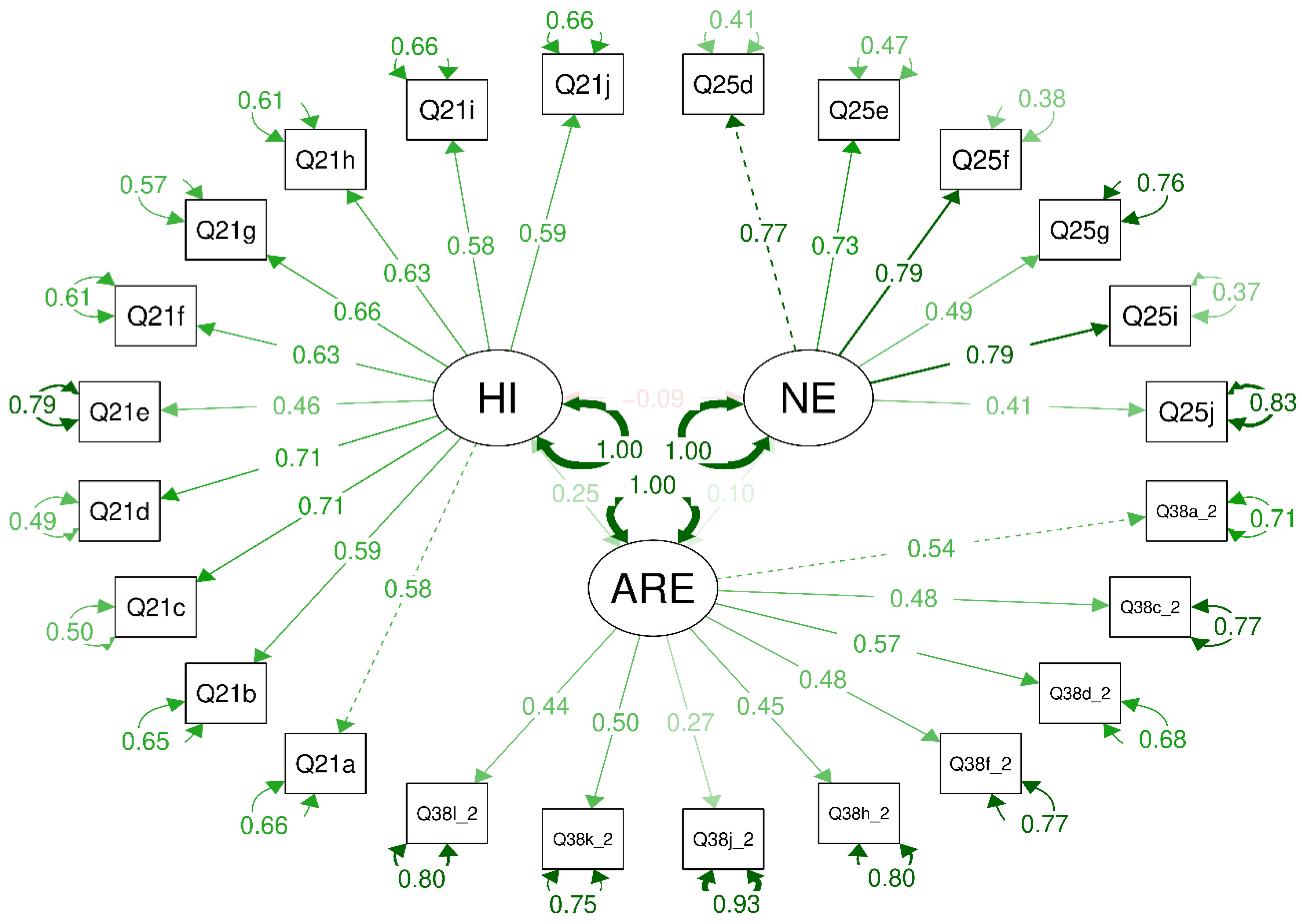
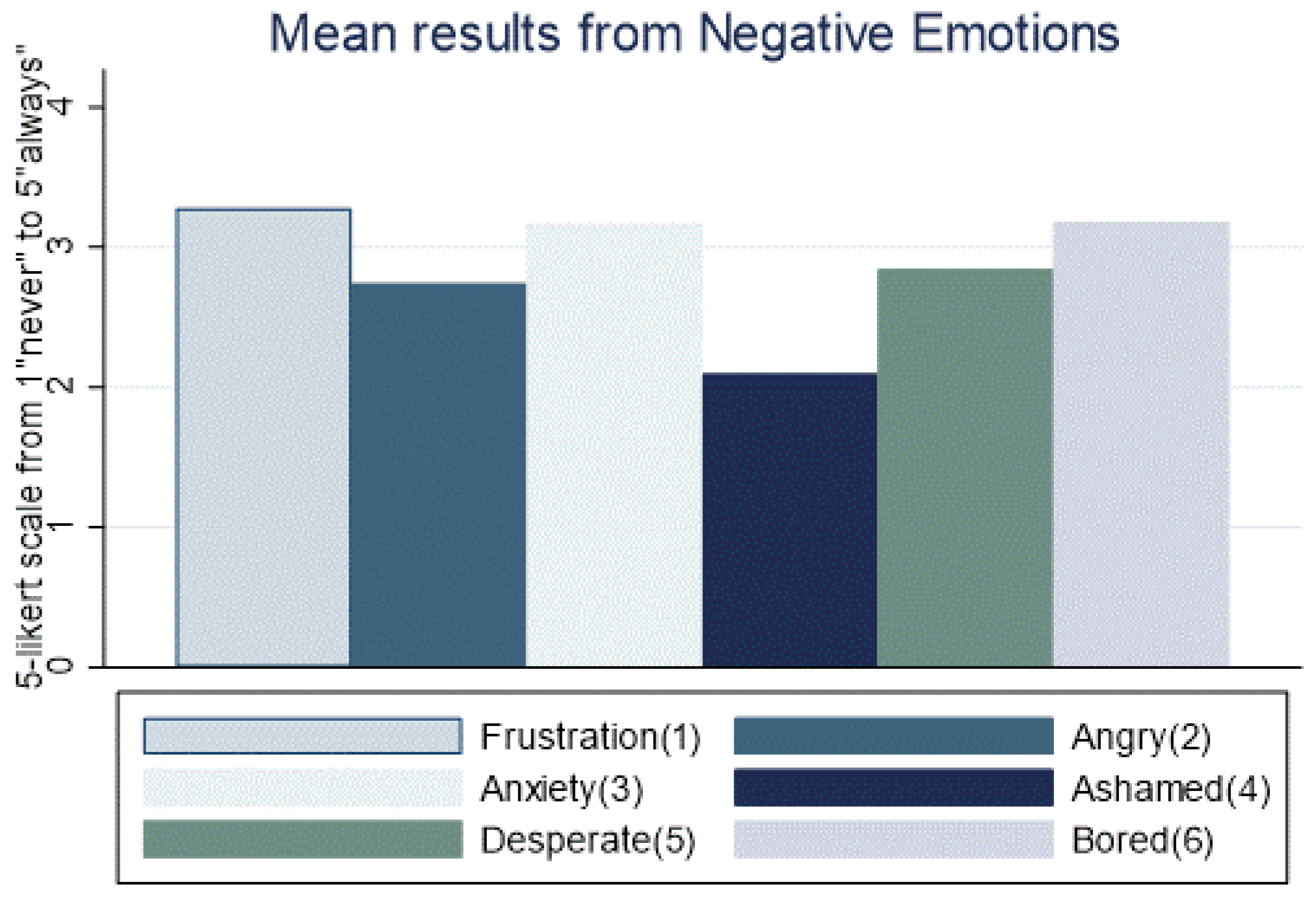
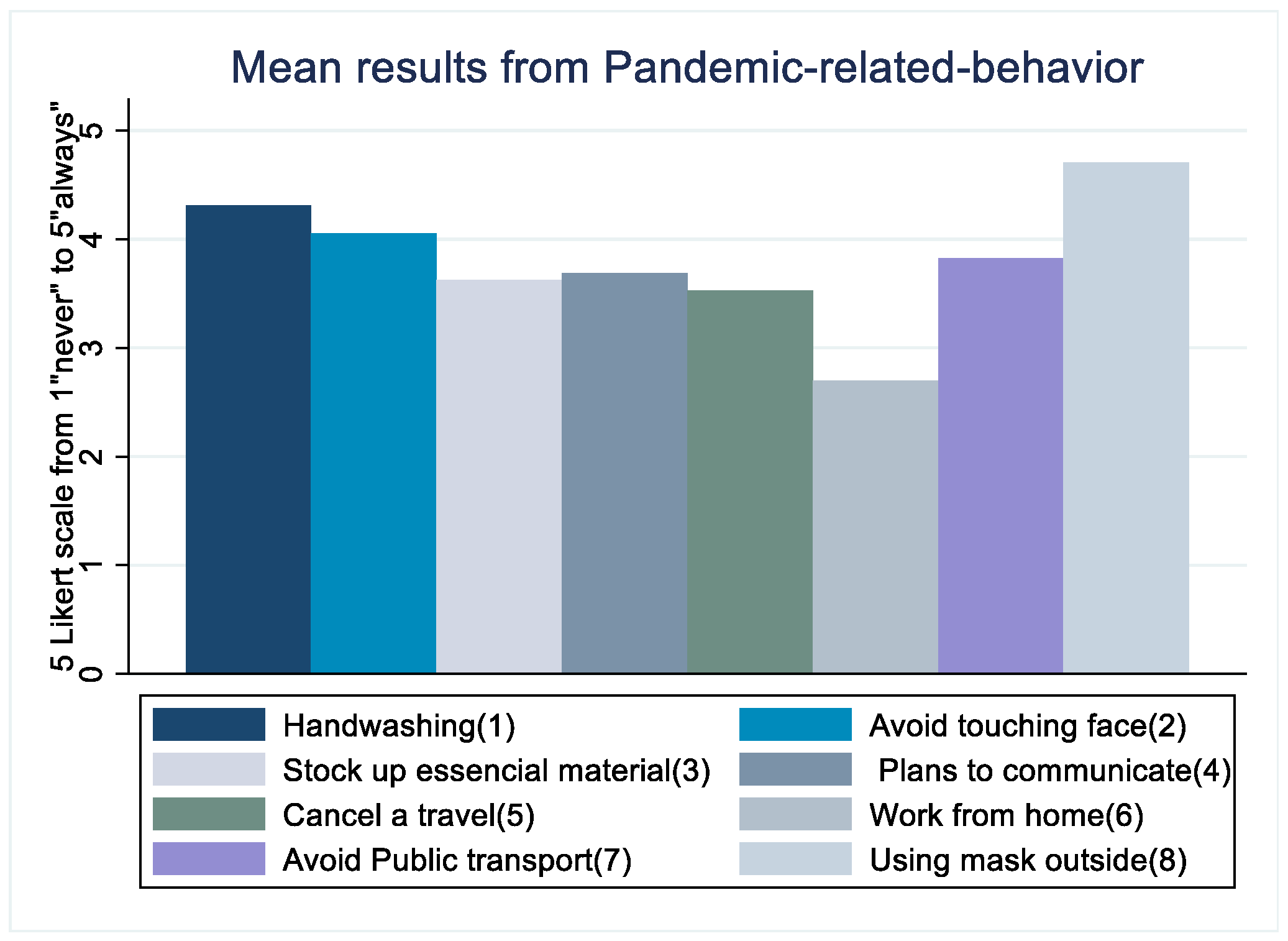
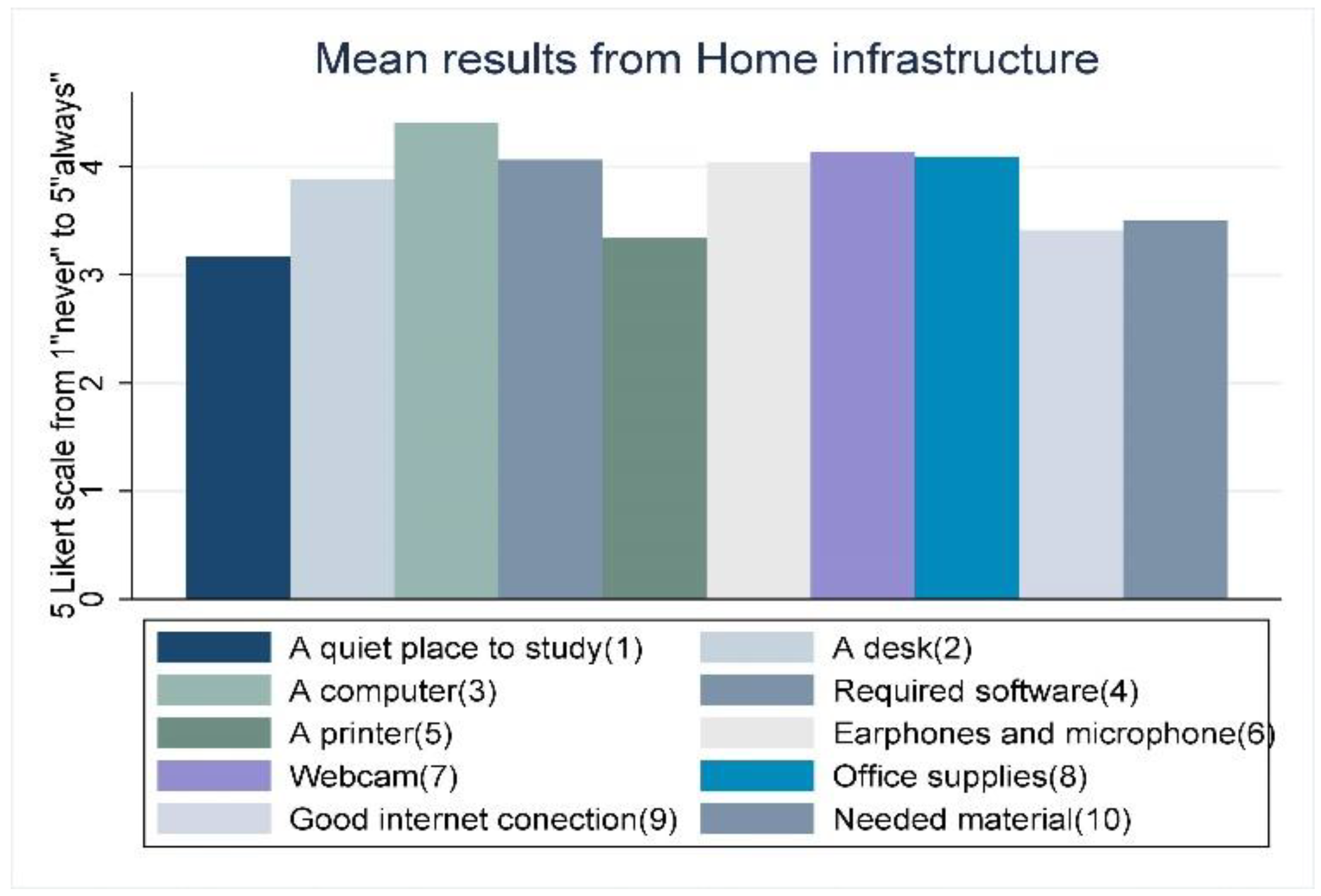
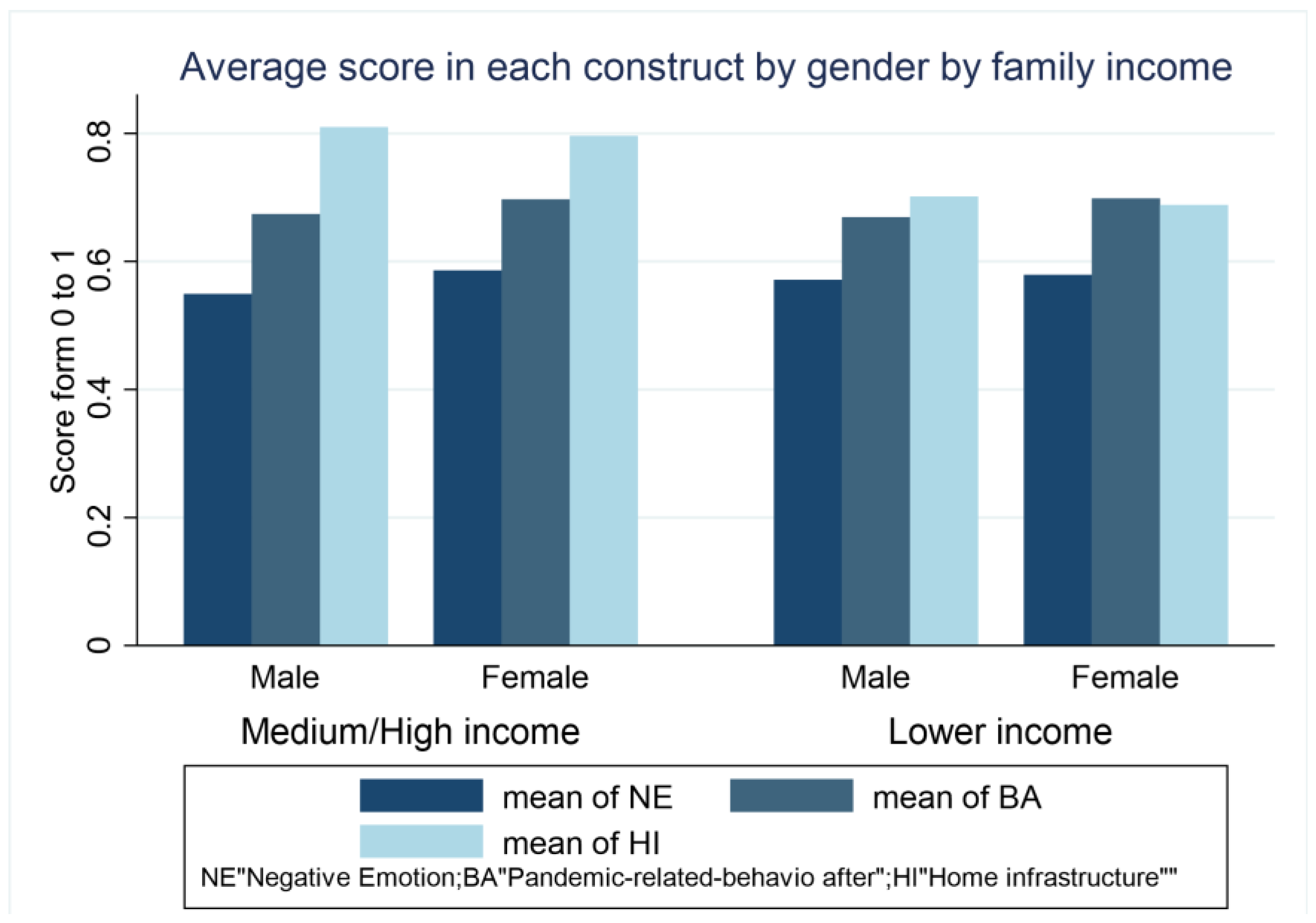
| Full Test | Negative Emotions (NE) | Behavior before (BRE) | Behavior after (ARE) | Behavior Variation (VRE) | Home Infrastructure (HI) | ||||
|---|---|---|---|---|---|---|---|---|---|
| Fit Indices | M1: (var Taken as Given) | M2: (Taking off Non-Significant) | M3: (with Variation) | M4: with “After Pandemic” | |||||
| Chi-square (value) | 2551.26 | 2081.63 | 773.33 | 875.62 | 58.46 | 123.98 | 141.66 | 92.18 | 371.38 |
| Chi-square (p-value) | 0.00 *** | 0.00 *** | 0.00 *** | 0.00 *** | 0.00 *** | 0.00 *** | 0.00 *** | 0.00 *** | 0.00 *** |
| Chi-square/df | 4.34 | 4.55 | 3.10 | 3.52 | 6.50 | 6.20 | 7.08 | 4.61 | 10.61 |
| CFI | 0.71 | 0.75 | 0.90 | 0.88 | 0.97 | 0.80 | 0.84 | 0.91 | 0.89 |
| TLI | 0.69 | 0.72 | 0.88 | 0.86 | 0.95 | 0.71 | 0.78 | 0.87 | 0.86 |
| SRMR | 0.072 | 0.07 | 0.049 | 0.053 | 0.029 | 0.058 | 0.054 | 0.04 | 0.05 |
| RMSEA | 0.067 | 0.069 | 0.053 | 0.058 | 0.08 | 0.08 | 0.09 | 0.07 | 0.11 |
| Cronbach’s Alpha | 0.70 | 0.73 | 0.76 | 0.76 | 0.83 | 0.53 | 0.66 | 0.71 | 0.86 |
| M3 | NE | VRE | HI | M4 | NE | ARE | HI |
|---|---|---|---|---|---|---|---|
| NE | 1 | NE | 1 | ||||
| VRE | 0.865 | 1 | ARE | 0.035 * | 1 | ||
| HI | 0.041 * | 0 *** | 1 | HI | 0.04 * | 0 *** | 1 |
| Question | Coefficients | R2 | Interpretation | |
|---|---|---|---|---|
| NE | Q25d | 0.77 | 0.59 | Moderate |
| Q25e | 0.73 | 0.53 | Moderate | |
| Q25f | 0.79 | 0.62 | Moderate | |
| Q25g | 0.49 | 0.24 | Weak | |
| Q25i | 0.79 | 0.62 | Moderate | |
| Q25j | 0.41 | 0.17 | Very weak | |
| ARE | Q38a_2 | 0.54 | 0.29 | Weak |
| Q38c_2 | 0.48 | 0.23 | Weak | |
| Q38d_2 | 0.57 | 0.32 | Weak | |
| Q38f_2 | 0.48 | 0.23 | Weak | |
| Q38h_2 | 0.45 | 0.20 | Weak | |
| Q38j_2 | 0.27 | 0.07 | Very weak | |
| Q38k_2 | 0.50 | 0.25 | Weak | |
| Q38l_2 | 0.44 | 0.19 | Weak | |
| HI | Q21a | 0.58 | 0.34 | Moderate |
| Q21b | 0.59 | 0.35 | Moderate | |
| Q21c | 0.71 | 0.50 | Moderate | |
| Q21d | 0.71 | 0.50 | Moderate | |
| Q21e | 0.46 | 0.21 | Weak | |
| Q21f | 0.63 | 0.40 | Moderate | |
| Q21g | 0.66 | 0.44 | Moderate | |
| Q21h | 0.63 | 0.40 | Moderate | |
| Q21i | 0.58 | 0.34 | Moderate | |
| Q21j | 0.59 | 0.35 | Moderate |
| Variable | Category | Groups | Mean | Mean Differences between Groups | |
|---|---|---|---|---|---|
| Parametric | Non-Parametric | ||||
| Negative emotions (NE) | gender | male | 0.558464 | 0.0384 * | |
| female | 0.58425 | ||||
| income | low income | 0.577894 | 0.5969 | ||
| medium income | 0.57086 | ||||
| complete group | 0.575259 | ||||
| Behavior after COVID-19 (ARE) | gender | male | 0.672599 | 0.0031 ** | |
| female | 0.697579 | ||||
| income | low income | 0.684783 | 0.9633 | ||
| medium income | 0.684645 | ||||
| complete group | 0.686074 | ||||
| Behavior variation (VRE) | gender | male | 0.326926 | 0 *** | |
| female | 0.435338 | ||||
| income | low income | 0.394204 | 0.5035 | ||
| medium income | 0.373619 | ||||
| complete group | 0.38366 | ||||
| Home Infrastructure (HI) | gender | male | 0.769086 | 0.0719 | |
| female | 0.749828 | ||||
| income | low income | 0.694476 | 0 *** | ||
| medium income | 0.801646 | ||||
| complete group | 0.75935 | ||||
| Variables | Category | β | p-Value | CI (95%) | |
|---|---|---|---|---|---|
| Model 4 (With outliers) | |||||
| Behavior After (ARE) | 0.127 | 0.029 * | 0.013 | 0.241 | |
| Home infrastructure (HI) | −0.078 | 0.064 | −0.160 | 0.005 | |
| _constant | 0.546 | 0.000 *** | 0.456 | 0.637 | |
| A model with demographic variables | |||||
| Behavior After (ARE) | 0.109 | 0.065 | −0.007 | 0.224 | |
| Home infrastructure (HI) | −0.086 | 0.059 | −0.174 | 0.003 | |
| Family Income | |||||
| low-income (1) | −0.008 | 0.564 | −0.037 | 0.020 | |
| Other (0) | |||||
| Online learning experience | |||||
| Previous experience (1) | −0.009 | 0.544 | −0.039 | 0.021 | |
| No (0) | |||||
| Zone of living | |||||
| Urban(centric) (1) | 0.005 | 0.673 | −0.020 | 0.031 | |
| Other (0) | |||||
| Gender | |||||
| Female (1) | 0.025 | 0.055 | −0.001 | 0.051 | |
| Male (0) | |||||
| Constant | 0.525 | 0.000 *** | 0.423 | 0.626 | |
| Model 4 (Without outliers) | |||||
| Behavior After (ARE) | 0.106 | 0.105 | −0.022 | 0.235 | |
| Home infrastructure (HI) | −0.092 | 0.044 * | −0.182 | −0.003 | |
| _constant | 0.558 | 0.000 *** | 0.452 | 0.663 | |
| A model with demographic variables | |||||
| Behavior After (ARE) | 0.100 | 0.132 | −0.030 | 0.231 | |
| Home infrastructure (HI) | −0.119 | 0.015 * | −0.215 | −0.024 | |
| Family Income | |||||
| low income (1) | −0.016 | 0.233 | −0.044 | 0.011 | |
| Other (0) | |||||
| Online learning experience | |||||
| Previous experience (1) | −0.017 | 0.258 | −0.045 | 0.012 | |
| No (0) | |||||
| Zone of living | |||||
| Urban(centric) (1) | 0.011 | 0.393 | −0.014 | 0.035 | |
| Other (0) | |||||
| Gender | |||||
| Female (1) | 0.018 | 0.149 | −0.006 | 0.042 | |
| Male (0) | |||||
| constant | |||||
| 0.573 | 0.000 *** | 0.441 | 0.669 | ||
Publisher’s Note: MDPI stays neutral with regard to jurisdictional claims in published maps and institutional affiliations. |
© 2022 by the authors. Licensee MDPI, Basel, Switzerland. This article is an open access article distributed under the terms and conditions of the Creative Commons Attribution (CC BY) license (https://creativecommons.org/licenses/by/4.0/).
Share and Cite
Méndez-Prado, S.M.; Flores Ulloa, A. The Impact Analysis of Psychological Issues and Pandemic-Related Variables on Ecuadorian University Students during COVID-19. Sustainability 2022, 14, 13123. https://doi.org/10.3390/su142013123
Méndez-Prado SM, Flores Ulloa A. The Impact Analysis of Psychological Issues and Pandemic-Related Variables on Ecuadorian University Students during COVID-19. Sustainability. 2022; 14(20):13123. https://doi.org/10.3390/su142013123
Chicago/Turabian StyleMéndez-Prado, Silvia Mariela, and Ariel Flores Ulloa. 2022. "The Impact Analysis of Psychological Issues and Pandemic-Related Variables on Ecuadorian University Students during COVID-19" Sustainability 14, no. 20: 13123. https://doi.org/10.3390/su142013123
APA StyleMéndez-Prado, S. M., & Flores Ulloa, A. (2022). The Impact Analysis of Psychological Issues and Pandemic-Related Variables on Ecuadorian University Students during COVID-19. Sustainability, 14(20), 13123. https://doi.org/10.3390/su142013123







